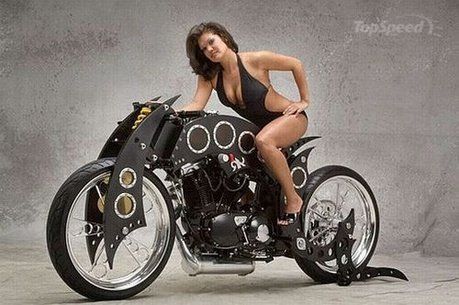
The year is 1950, inside the assembly shop at Stevenage, and it tells a story about the state of British industry, and the now legendary Vincent factory. The factory building itself is obviously quite small, with natural skylighting (how different from today's big box ass'y plants) and a few flourescents hanging above - no task lighting at all. Clearly, each carpenter-built table is the responsibility of one mechanic, who assembles the machine from the store of spares behind. I would assume, like the rest of British motorcycle industry, that 'selective assembly' was the key to a good engine - if the part doesn't fit well, reach for another, perhaps it will fit better - the aged machine tools in use couldn't produce truly consistent machined parts, so minor variations in tolerance could make all the difference between a Rapide which might do 105 or 115mph.
Not that selective assembly was a bad thing - Ducati was still using the system on their 900ss in the 1970's!
The second photo shows the very first Series 'B' Black Shadow being assembled by Mr Bowens (with back to wall). Note high-tech, purpose-built assembly bolsters! Those blocks in use as engine
.jpg) supports are remainders from Vincent's war effort, and previously contained fuses (as in bomb).
supports are remainders from Vincent's war effort, and previously contained fuses (as in bomb). I got a note from David Bowens, whose father is shown assembling the Shadow. According to David, in the top photo, the pile of bits in the foreground would have been non-fitting, rejected parts from the assembly job at hand, "hard facts which a lot of people don't like to hear; a lot of owners only want to hear fairy stories".
I have another take; it's enlightening to peer inside these buildings and see how our bikes were made - nowadays we see videos of modern, surgically clean factories with purpose-built fixtures and robotic tools. Any bike made in England before the 1960's was probably built in exactly the same manner as these Vincents, with each employees performing a range of tasks, such as building up an engine, or assembling the bike around the power train. The factories had no great reserves of investment capital to purchase the very latest and best in equipment, and used machine tools which likely dated from the 1920's (or even earlier, in the case of Veloce, who used belt-driven Victorian-era lathes).
Thus, what you have, if you own such a machine, is a hand-made, or better yet, a machinist-made motorcycle, a true tool-room special, with each part individually chosen or sweated over or cursed into shape. There was no soulless robotic assembly line which spat out a shiny new Vincent or Norton or Rudge, each of these vintage machines had the workers' hands all over their insides and outsides. And, at the end of this manual effort, the motorcycles performed, and still perform, with thrilling speed and roadworthiness. I see no shame in the factory using old ammo boxes and carpenter-built benches, in fact just the opposite; I see glory.








No comments:
Post a Comment